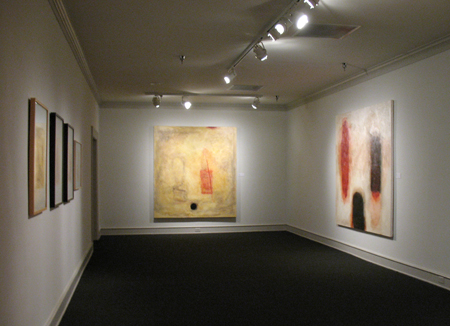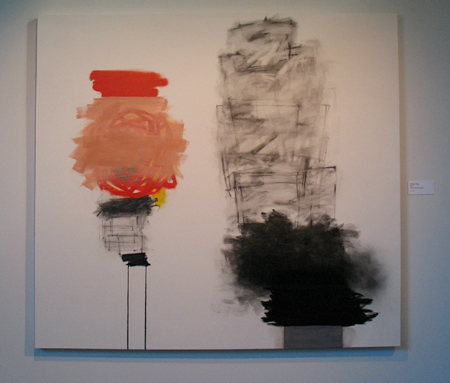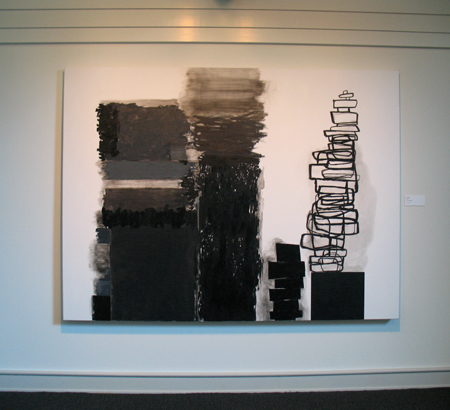Last Saturday I caught the final weekend for the Rocio Rodriguez exhibit at the Columbus Museum of Art in Columbus, GA. I had never been to the space before and was pleasantly surprised. The painter had an exhibit at Sandler Hudson gallery in Atlanta earlier this year, but sadly I missed it. A 24 year retrospective in the third floor galleries, the show in Columbus included a selection of her works from 1988 to 2012.
The Command, 1988. Oil on canvas 84×91 inches. On loan from the High Museum of Art.
The Shield, 1991. Oil on canvas 84×80.5 inches.  Courtesy the artist.
Starting in the late 1980’s, the work during these decades spans several incarnations, including figurative, abstract and computer assisted work that relates to the Iraq war. The early works bring to mind Bay Area figurative artists like Manuel Neri and Nathan Oliveira. Â Some of the grid making on paintings like “Time” echo those of Cy Twombly or Mark Tobey.
Time, 1995. Oil on canvas, 84×154 inches.  Courtesy the artist.
October 23, ’06, No.1. Pastel, oil pastel, pencil on paper.  Courtesy the artist.
Rodriguez seems to limit her palette to warm colors, with the exception of additions of pale blue in early works. One pastel from 2006 includes a deep ultramarine upper quadrant with what could be construed as stars in its half oval. Black, orange and red are predominant colors that she uses throughout.
Saffron Hands, 1994. Oil on canvas. On loan from David Joel.
In 1996 on a 3 month residency in Rome, Rodriguez began experimenting with decorative motifs, inspired by architecture and memories of her Cuban childhood. The museum brochure states that her work during this period rejected a “modernist attitude that was inclined to view beauty as a superficial concern.”
Roman Codex I, 1997. Oil on canvas, 77×84 inches. On loan from the New Orleans Museum of Art.
I especially like that Rodriguez is not shy about stating her stance in support of beauty, in opposition to what is an “acquired response in art circles.” She questions whether the beautiful can’t be provocative or engaging. She notes that she doesn’t “ascribe to absolutes, and my paintings don’t depend on theoretical positions but on the experiential.”Â
In  1999 she returned to Italy and spent time working on pieces in which she deconstructed and rubbed out the subject matter.
Slit and Trace, 2002. Oil on canvas, 60×82 inches. On loan from David Joel.
From 2005 to 2009, Rodriguez developed a series based on photographs and maps of the Iraq war. Her palette concentrates on earth colors similar to those found in the desert; reds, ochres, dark browns, on what appeared to be raw canvas in some cases. The artist has said that the basis for using red in some of these works is the obvious symbolism for conflict, but her choices in color are normally intuitive and not contrived.
The Round City – Baghdad, 2007. Oil on canvas, 72×120 inches. Courtesy the artist.
Using her computer to upload her own drawings and photographs, she devised the basis for these large works. These do remind me of imagery generated by computers, especially beta versions of paint programs that I used in the 1990s when computer animation and automated rotoscoping tools were first being developed.
Rodriguez again shifted styles in the early 2000’s, returning to expressionist brushwork and reducing content. Some of these works combine media; pastel, pencil and oil or oil and acrylic.  In the latest paintings, she combines architectural elements with gesture and achieves emotional resonance through spare color combinations.
Orange Trace, 2012. Oil and acrylic on canvas, 72×78.5 inches.  Courtesy the artist.
Totem, 2011. Oil on canvas, 69.5×92.75 inches.  Courtesy the artist.
A review in Art in America can be found here. You can also view Rodriguez’s works in the High Museum’s permanent collection. Rodriguez’s website offers a conversation between the artist and critic and curator Lily Wei.
The museum also has a fairly good contemporary collection, if small, and a similar mix of Ashcan and American impressionist works. Slightly disconcerting are teaching moment blurbs next to the permanent works, describing the piece and offering a somewhat subjective analysis. As in Alice Neel’s ‘Swedish Girls’:
Louise Nevelson. Silence-Music 1, 1974-1982. Painted wood. Gift of Mrs. Richard Jennings by exchange.
Robert Motherwell. Massive Image, 1991, acrylic on canvas. Museum purchase made possible by various donations.
Ida Kohlmeyer. Passage #2, 1963. Gift of the artist.
More on the collection in my next post.

























Thanks for the tour, I’ve never been.
It’s a nice museum, Terry – but don’t know what you’d make of the architecture.